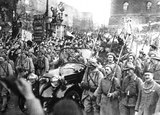A special role in the creation of Czechoslovakia was played by the Czechoslovakian legions fighting at the side of the Entente armies. These legions consisted of voluntary units of émigré Czechs, but mostly of defectors and prisoners of war from the ranks of the Imperial-Royal Army.
These military units were to lend tangible weight to the hitherto theoretical concepts of an independent Czechoslovakia: the engagement on the side of the Entente Powers was not restricted merely to political agitation, but also included armed combat against the Central Powers.
The Czechoslovakian legions eventually numbered forces of around 100,000 men. The largest group involved the Czech units in the Russian Army, with 77,000 men. These were recruited from defectors and prisoners of war who were persuaded to enlist. Desertion was a massive problem for the Imperial-Royal Army in the Russian theatre of war and eventually caused the Austrian generals to judge Czech soldiers across the board as unwilling to fight.
An international stir was caused above all by the role the Czechoslovakian legions played during the Russian Revolution. After the Bolsheviks seized power, the legionaries moved onto the side of the bourgeoisie White Guard in the Russian Civil War and fought against the Red Army. The hopeless struggle ended with the occupation of Vladivostok in Siberia, whence, until the end of 1920, the Czechoslovakian legionaries were evacuated to Czechoslovakia.
The Czechoslovakian legions played a different role in the Western Alliance. In December 1917, a troop corps formed of 12,000 men fought as allied army on the side of France. In April 1918, Italy, too, recognised the founding of a political and legally sovereign Czechoslovakian Army. The Czechoslovakian legions fighting on the side of France and Italy were thus deemed to be an autonomous army of a sovereign state – in contrast to the legions in Russia, who had served as part of the regular Russian Army: Czechoslovakia was at the time still a virtual nation and without territory defined by international law. But it already had armed forces at its disposal.
After the gaining of independence the Czechoslovakian legions also formed the basis of a Czechoslovakian Army. The first soldiers returning from the Italian Front were even involved in the conflicts over the claims of national territory immediately after the collapse of the Monarchy in autumn 1918. New-born Czechoslovakia was very much aware of the significance of the legions. They were regarded as one of the ideological pillars of the ”foundational myth” of the state. The veterans were much acclaimed, streets, squares and bridges were named after them in every town and city. The organisation formed of former legionaries (Československá obec legionářská) was a major political force.
Nevertheless, the one-sided accentuation of the legions’ positive role in the official historical awareness of the Czechoslovakian nation had negative consequences. The overwhelming majority of the Czechs and Slovaks (and not forgetting the present minorities of Germans and Magyars) served as loyal soldiers in the Imperial-Royal Army until the collapse of the Monarchy. This ideological gap in the culture of memory could not be bridged, which of course did not contribute to the country’s cohesion.
Translation: Abigail Prohaska
Bihl, Wolfdieter: Der Erste Weltkrieg 1914–1918. Chronik – Daten – Fakten, Wien/Köln/Weimar 2010
Hoensch, Jörg K.: Geschichte Böhmens. Von der slavischen Landnahme bis ins 20. Jahrhundert, München 1987
Lein, Richard: Pflichterfüllung oder Hochverrat? Die tschechischen Soldaten Österreich-Ungarns im Ersten Weltkrieg [Europa Orientalis 9], Wien [u.a.] 2009
Rauchensteiner, Manfried: Der Erste Weltkrieg und das Ende der Habsburgermonarchie 1914–1918, Wien u. a. 2013
-
Chapters
- Delenda Austria – Austria must be destroyed!
- The aim of state independence: from Utopia to a programme for the masses
- Preparing for the Coup
- The Day of the Coup: 28 October 1918
- The Founding of Czechoslovakia
- The Czechoslovakian Republic as Successor State to Austria-Hungary
- The Czechoslovakian Legions
- The Fall of the Symbols of Habsburg Rule




